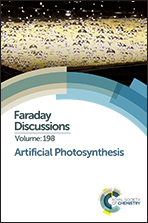Stable hybrid organic/inorganic photocathodes for hydrogen evolution with amorphous WO3 hole selective contacts†
Abstract
Photoelectrochemical H2 production through hybrid organic/inorganic interfaces exploits the capability of polymeric absorbers to drive photo-induced electron transfer to an electrocatalyst in a water environment. Photoelectrode architectures based on solution-processed organic semiconductors are now emerging as low-cost alternatives to crystalline inorganic semiconductors based on Si, oxides and III–V alloys. In this work, we demonstrate that the stability of a hybrid organic/inorganic photocathode, employing a P3HT:PCBM blend as photoactive material, can be considerably improved by introducing an electrochemically stable WO3 hole selective layer, paired with a TiO2 electron selective layer. This hybrid photoelectrode exhibits a photocurrent of 2.48 mA cm−2 at 0 VRHE, +0.56 VRHE onset potential and a state-of the art operational activity of more than 10 hours. This work gives the perspective that photoelectrodes based on organic semiconductors, coupled with proper inorganic selective contacts, represent a sound new option for the efficient and durable photoelectrochemical conversion of solar energy into fuels.
- This article is part of the themed collection: Artificial Photosynthesis

 Please wait while we load your content...
Please wait while we load your content...